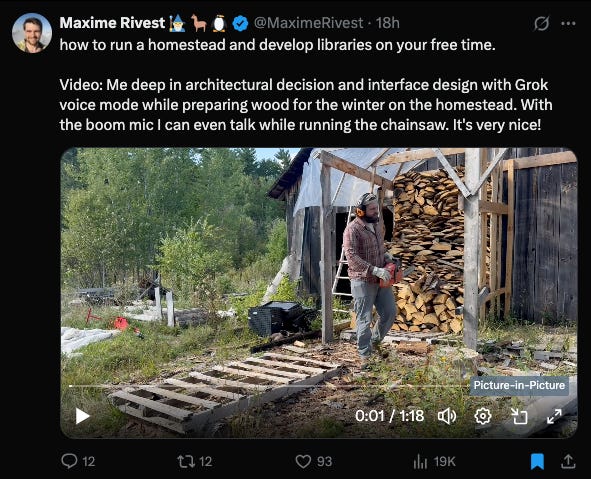AI Composability and the Terminal
The unexpected ergonomics of coding CLIs and how that impacts other AI use cases.
Clearly the best way of using AI is by talking to Grok using bluetooth-enabled hearing protection gear.
But what is the second best way?
I think it’s CLIs (Command Line Interfaces).
Coding has the strongest PMF of any LLM use cases as I talked about in August:
One hypothesis is that OpenAI was (rationally) focused on coding performance. LLMs seem to have achieved the strongest product market fit in coding assistance. Personally, I find they are quite handy at finding sources during research runs too but people are more easily impressed with suddenly being able to create a video game than they are with a well-referenced report.
But I don't think that’s the only reason why CLIs are good. Not even all developers prefer CLIs. Yes there is the odd “sysadmin” Linux-maximalist persona that runs their life on Bash but the are equally many (or more) developers that tolerate and enjoy apps like XCode, haven't touched Vim or emacs and love to click and install things on their Mac.
The real reason is composability. It's simply accidental that CLIs are not accessible to non-developers and therefore only used for coding agents. They could actually be used for much, much more.
THE RISE OF CODING CLIS
The progression of which AI coding tool is winning is complex to track but in broad sweeps it went something like this: GitHub Copilot → Cursor → Windsurf (very briefly) → Claude Code → OpenAI Codex CLI?.
Copilot, Cursor and Windsurf were built into VSCode so it may first seem as a regression to drop from a UI to a CLI.
But the actual experience isn't that different. Since most IDEs like Vim and VSCode provide a built-in terminal, Claude Code can just exist there.
This is actually what originally prompted Claude Code to be developed as a CLI. Anthropic’s own developers had an irreconcilable set of preferences for IDEs and a CLI was a way to allow all of them to access the agent.
From there, Claude Code became the dominant coding agent for many developers and has sat unchallenged until the recent GPT-5 and Codex launch.
If you’re wondering if non-developers can use these tools without getting their hands dirty, I just don't think there is a better way.
I've tried the in-browser version of OpenAI Codex and I can't imagine anyone using that reliably (compared to the CLI). Reviewing code is fine if you are working with highly competent team members but that’s not what current LLMs represent at this stage. I touched on the skill demands on vibe coders in The Delegation Window.
Once the CLI was built, the Anthropic team realized several benefits: a fast speed of iteration (no UI surface) AND compatibility with other tools.
Which leads us to composability.
COMPOSABILITY
Composability is what initially drew me to blockchains and I think is the reason why CLI interfaces have been so successful in coding.
There are an infinite amount of workflows which are enabled by the flexibility of these interfaces:
Working remotely via SSH (e.g., working from an iPad);
Running multiple agents in parallel;
Configuring agents (simply using local Markdown files);
Using the CLI as an MCP tool in another agent;
Using the CLI for one-off tasks (even using it from other tools, bash scripts or other coding agents);
etc.
In fact, users are finding use cases for these tools outside development such as programmatic SEO.
The subagents feature in Claude Code is very unique and I don't think anything comes close outside of coding.
MOVING BEYOND THE CLI
Of course not every non-technical person can get onboarded to the CLI or be as productive as developers.
Eventually AI tools will have to find other mediums for composability. But we don't really know what that looks like yet.
Blockchains are more of a composable deployment destination for apps instead of a workspace.
Notion and Airtable are working hard to be modern workspaces but their performance suffers radically when doing anything of scale!
Tables don't work well in Notion. And Airtable is only good for tables.
Google Drive is used as a database for many AI automations, allowing apps to programmatically create Google Docs on the fly. Unfortunately Google Drive itself is just a file browser in the cloud.
Someone has yet to build the AI-native in-cloud workspace for AI but for now CLIs are pretty damn good.






